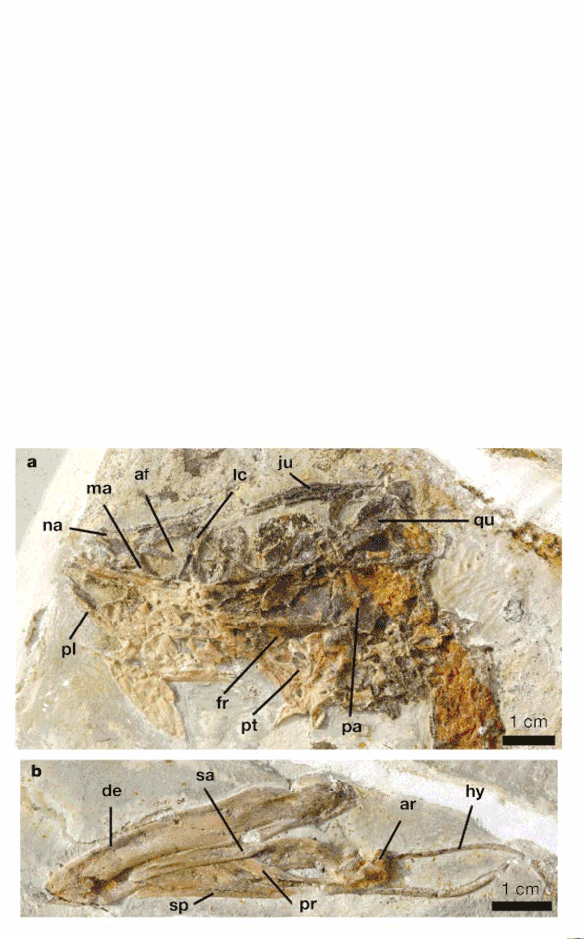

| Online: | |
| Visits: | |
| Stories: |
Jeholornis nests within current Archaeopteryx specimens
That Jeholornis nests
as the Chinese Archaeopteryx comes as no surprise. Jeholornis was always considered a close relative of Archaeopteryx. The key difference here (Fig. 1) in this subset of the large reptile tree is that earlier we nested several specimens of Archaeopteryx at the bases of all the later major bird clades (Fig. 1). That’s an unorthodox hypothesis seeking acceptance and widespread practice.

Figure 1. Subset of the large reptile tree focusing on birds, not including bird-like taxa in more basal clades. Not the nesting of Jeholornis within the clade of Solnhofen birds, too often lumped under a single taxon, Archaeopteryx.
Now we can nest Jeholornis
with between certain specimens of Archaeopteryx and not others.
- Archaeopteryx siemensii (Thermopolis specimen) – basalmost Aves
- Archaeopteryx siemensii (Berlin specimen)- basal Enantiornithes
- Archaeopteryx lithographica (London specimen- holotype)- basal Enantiornithes
- Archaeopteryx bavarica – basal Scansioropterygidae
- Jeholornis prima – basalmost Ornithurae
- Archaeopteryx [Jurapteryx] recurva (Eichstaett specimen) basal Ornithurae (including extant birds)
- Archaeopteryx [Welllnhoferia] grandis (Solhnhofen specimen) – Confuciusornithiformes (within Ornithurae)
The nesting of Jeholornis within the clade of basal Solnhofen birds solves many problems.
Jeholornis is the only long-tailed avian genus from China.
Zhou and Zhang 2002 report, “This bird is distinctively different from other known birds of the Early Cretaceous period in retaining a long skeletal tail with unexpected elongated prezygopophyses and chevrons, resembling that of dromaeosaurids, providing a further link between birds and non-avian theropods.”
O’Connor et al. 2011 report, “The Early Cretaceous long bony-tailed bird Jeholornis prima displays characters both more basal than Archaeopteryx and more derived, exemplifying the mosaic distribution of advanced avian features that characterises early avian evolution and obfuscates attempts to understand early bird relationships.”
Confusion over the nesting
of Jeholornis has probably resulted from taxon exclusion. Virtually all prior studies included only one Archaeopteryx as a taxon. Which one? I don’t know. More taxa of Solnhofen birds need to be added.
Contra Zhou and Zhang 2002
in the large reptile tree, birds are not derived from dromaeosaurids, but from increasingly bird-like troodontids like Sinornithoides, Aurornis, Anchiornis, Eosinosauropteryx, and Xiaotingia.

Figure 2. The holotype of Jeholornis skull traced and reconstructed using DGS methods. Here maxillary teeth and the premaxilla were identified. Colorizing helps identify bones more easily than simple black outlines. If you see any errors, pleas call them to my attention. The postorbital is reconstructed with a process entering the orbit. This is an unrestored break, not a real process.
Maxillary teeth
Zhou and Zhang 2002 report, “The maxilla is reduced and does not bear any teeth.” Using Photoshop and the DGS method, I was able to find left maxillary teeth in the holotype of Jeholornis (Fig. 2). The right maxillary teeth may be scattered or buried. The premaxilla (with teeth) was found to be jammed up against the other rostral bones.
Flapping
Zhou and Zhang 2002 report, “The derived features of the pectoral girdle of Jeholornis such as a strut-like coracoid and the well-developed carpal trochlea of the carpometacarpus, suggest the capability of powerful flight.” I agree.
Also note
Sapeornis nests within the Ornithurae grade with this list of taxa as other Sapeornithiformes are not currently listed. We’ll look at the skull tomorrow.
Jeholornis is not the first archaeopteryx-like bird from China.
We also have the Liaoning embryo, which nests with the holotype of Archaeopteryx, the London specimen (Fig. 1). Basically, only the relatively large skull, large orbit and small, gracile cervicals of the embryo, distinguish the two taxa, but then those are juvenile traits in birds that change allometrically during ontogeny.
The Jehol Group
(according to O’Connor et al. 2011) “consists of three formations, namely the Dabeigou, Yixian and Jiufotang (Zhou 2006), which record primarily lake and volcanic deposits that are approximately 131 to 120 Ma old (He et al. 2004, 2006; Yang et al. 2007; Zhu et al. 2007). The youngest formation of the Jehol Group, the Jiufotang Formation, preserves the most diverse Mesozoic avifauna known in the world, with long-tailed birds most closely related to Archaeopteryx living alongside the earliest ornithurines (Zhou 2006).”
Lumping or splitting
Some paleontologists lump all Archaeopteryx specimens together. Phylogenetic analysis (Fig. 1) indicates they should be split apart. That needs to start happening in bird studies. I’m happy to support it and promote it.
In similar fashion
earlier I disagreed with those who lump all Rhamphorhynchus specimens together. Phylogenetic analysis is able to split them apart and even find a juvenile of a giant. This juvenile is the size of smaller adult species, hence the confusion.
For those still insisting that the large reptile tree needs more ‘key’ characters
let me remind you that the currently employed list of non-theropod, non-bird specific character traits is doing a better job of lumping and splitting 645 taxa with the current list of 228 traits, (151 parsimony informative traits in theropods), even while testing close matches, like Jeholornis, to current taxa like the several Archaeopteryx specimens. We have a saying here in the USA: “If it ain’t broke, don’t fix it.”
References
O’Connor JK, Sun C-K, Xu X, Wang X-L and Zhou Z-H 2011. A new species of Jeholornis with complete caudal integument. Historical Biology iFirst article, 2011, 1–13.
Zhou Z-H and Zhang F-C 2002. A long-tailed, seed-eating bird from
the Early Cretaceous of China. Nature 418:405-409.
Source: https://pterosaurheresies.wordpress.com/2016/02/02/jeholornis-nests-within-current-archaeopteryx-specimens/



